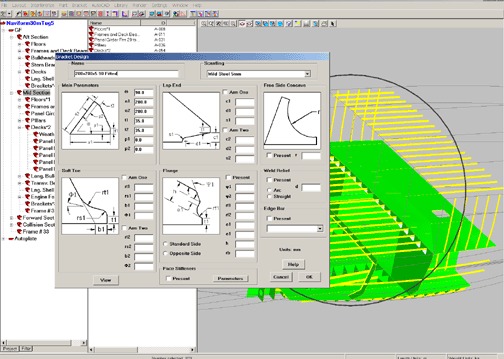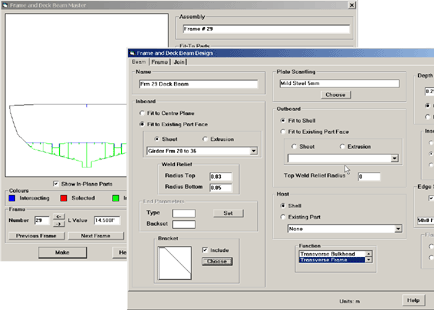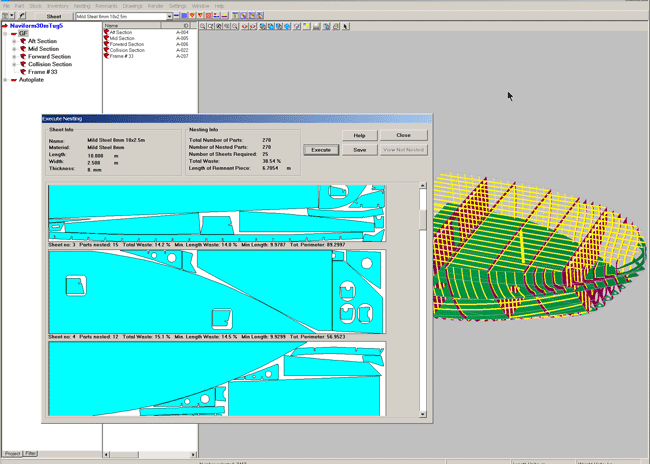Complete Vessel Structure Modelling & Part Nesting by Autoship Systems

If you are in the market for accurate yet fast vessel design, structural modeling and part nesting, then read on. Autoship Systems Corporation (ASC) has developed a complete CAD/CAM suite to meet the CAD/CAM needs in marine vessel design and construction. In this article, we review two key programs in the CAD/CAM suite: Autostructure 3.0 and Production Manager 3.0.
Product Review
Autostructure and Production Manager are key components in the Autoship CAD/CAM suite. These two state-of-the-art programs offer shipyards all they need in structural design, pre-construction drawing preparation and part nesting, and at very affordable prices.
Autostructure is used to create a 3D model of a vessel structure and to output the parts of that model in CAD format. The CAD representation can be used either to prepare construction drawings or for input to NC cutting processors. Autostructure utilizes an Autoship-generated hull and/or superstructure and can also include the shell plate information created in Autoplate. (Autoship and Autoplate are programs in the Autoship Systems CAD/CAM suite).
Every aspect of Autostructure was designed to allow parts to be created quickly and with minimal input. While there is a general workflow, no set ways or sequences are forced upon the user, thus enabling maximum productivity with minimum effort. And since parts can be generated rapidly, mistakes can be quickly and easily remedied. Also, if a part is changed or moved, Autostructure can update the surrounding structure for you, saving you time and effort.

The tools that Autostructure provides are:
1) A part database with a powerful categorization system
2) The ability to rapidly cut parts to the shell and/or each other
3) Sophisticated 2D part editing
4) Comprehensive CAD output
5) Extensive reporting capabilities
6) A user-expandable Material library
7) Library of user-designed brackets
8) Parametric frame and deck beam design
Autostructure has an interface with the piping design system “AutoPLANT™” by Bentley Systems Inc. Data exchange between the two programs allows for coordination of design between piping designers and structure designers, hence avoiding costly rework on the vessel construction site.
All parts designed in Autostructure can be imported into Production Manager for nesting and related processing. Production Manager provides sheet and linear (extrusion, flat bar) nesting, part subdivision, weld shrinkage compensation, stock definition, stock inventory and stock remnant management.

Production Manager’s key features include:
- Takes part information from the Autostructure database
- Subdivision of sheet parts and extrusions to fit stock sizes
- Dimensional compensation for weld shrinkage
- Stock definition for sheet, extrusion and flat bar
- Automatic sheet nesting with a choice of algorithms and parameters
- Optional manual or mixed manual-automatic nesting
- User definition of stock edge allowance and inter-part gap
- Part in hole nesting
- Batch nesting of multiple sheets
- Flat bars nested either as sheet parts or by linear nesting
- Optimal use of extrusion stock
- User defined sheet remnants
- Nesting on remnants
- Optional inventory acquisition for sheet, extrusions and flat bars
- Automatic inventory deduction when nestings are exported
- Remnant inventory control
- Nesting drawing exported directly to AutoCAD™
- Multiple drawing layers for part outlines, openings, marks and labels
- Nesting reports
- Part tracking identifies all parts cut from a single sheet and its remnants
Together, Autostructure and Production Manager give you complete control over vessel structure design and nesting, plus integration with third party piping. These components have completed the ASC CAD/CAM suite. The marketplace has already responded favourably.
The Autoship CAD/CAM suite: a quick overview
The ASC CAD/CAM suite includes programs used for vessel surface modeling, hydrostatic and strength analyses, powering, structural modeling, plate expansion and nesting. The programs are fully integrated, so the transfer of the model from one program to the next is both error free and effortless. Standard file exchanges are fully supported allowing data exchange with many third party programs.
